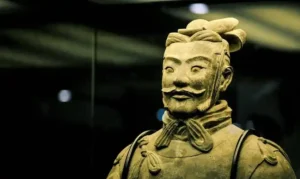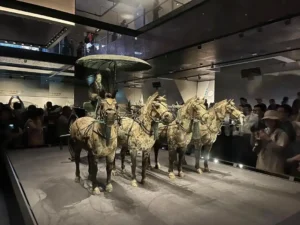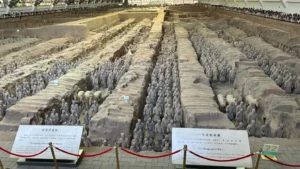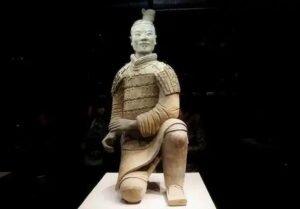2025 Exploring the Terracotta Army: A Historical Echo Across Millennia
In central China, Xi’an is home to the astonishing Terracotta Army. Hidden underground for over 2,000 years, its discovery amazed the world with grand scale, fine artistry, and rich history, standing as a gem of human civilization.
I. Historical Origins: An Imperial Legacy
In 221 BC, Ying Zheng, the First Emperor of Qin, unified China and founded the first centralized feudal dynasty. Wishing to maintain power in the afterlife, he ordered a huge mausoleum’s construction. The Terracotta Army, part of this mausoleum, was meant to guard the emperor. Craftsmen from all over spent decades making these lifelike clay warriors. Each, with unique faces, expressions, and uniforms, reflects the Qin Dynasty’s military, showing the era’s craftsmanship and laborers’ wisdom.

II. Unique Values
(1) Artistic Marvel
The Terracotta Army is a peak of ancient Chinese sculpture. Warriors’ faces show various expressions, from resolute to solemn. Their bodies have correct proportions, natural postures, and detailed costumes. These artworks not only show high – level skills but also reflect Qin’s social and aesthetic values, giving precious insights into ancient Chinese art.

(2) Historical Window
Studying the Terracotta Army’s formations reveals the Qin Dynasty’s military system, like army structure and weaponry. The arrangements of infantry, cavalry, and chariot warriors mirror the era’s tactics. Inscriptions and clothing details on the warriors also offer clues about Qin’s politics, economy, and culture, helping us recreate this past era.
(3) Cultural Icon
As a symbol of Chinese culture, the Terracotta Army shows respect for ancestors and historical continuity. As a UNESCO World Heritage Site, it draws global visitors and scholars, acting as a key bridge for cross – cultural exchanges. It shows the depth and charm of Chinese civilization, promoting understanding among nations.
III. Travel Guide
(1) Ideal Visiting Times
Spring (March – May) and autumn (September – November) are the best times. The weather is mild, avoiding summer’s heat and winter’s cold. This makes for a more comfortable visit. Also, choose weekdays over weekends and holidays to avoid big crowds, allowing for a more relaxed visit to appreciate the warriors and soak in the history.
(2) Photography Spots
- Pit 1 Panorama: Pit 1, the largest, offers a stunning view. Standing on the viewing platform, capture the orderly warrior formations. Shoot between 10 am – 3 pm for the best lighting, highlighting the army’s grandeur.

- Kneeling Archer Close – up: Pit 2’s kneeling archer, a masterpiece, has unique features. Take a close – up of its face and details in the display area, using natural light to protect the artifact.

- Museum Square: The square outside the museum, with its Qin – style buildings like the First Emperor’s statue and carriage replicas, makes a great backdrop. The surrounding greenery and flowers add to the charm for commemorative photos.
(3) Practical Tips
- Ticket Pre – booking: The Terracotta Army site uses real – name ticketing. Book in advance on the official website or travel platforms. This avoids long queues and ensures entry. Choose your visit date and time carefully to plan your day.
- Transportation: From downtown Xi’an, take Metro Line 9 to Huaqing Palace Station and transfer to a shuttle or bus. You can also take Bus No. 5 (306) from Xi’an Railway Station’s East Square. Make sure to use legal transportation.
- Guided Tours: To fully understand the Terracotta Army’s stories, rent a multi – language audio guide or join a guided tour. Guides can give in – depth explanations and answer questions. These services are available at the entrance.
- Visit Sequence: Start at the Terracotta Army Museum to learn about the discovery, excavation, and history. Then, visit Pits 1, 2, and 3. This helps you better understand the actual displays.
- Precautions: Never touch the terracotta warriors or other relics; they are fragile. Keep quiet to respect the site and other visitors. While there are dining areas, prices may be high, so consider bringing light snacks and water.
The Terracotta Army, a doorway to the past, awaits your exploration. Stepping here, you travel through time, connecting with history. Whether you love history or art, this site promises an unforgettable experience. Start your historical adventure at the Terracotta Army today!




gHMeSI sEPnyX cSFUba
hello